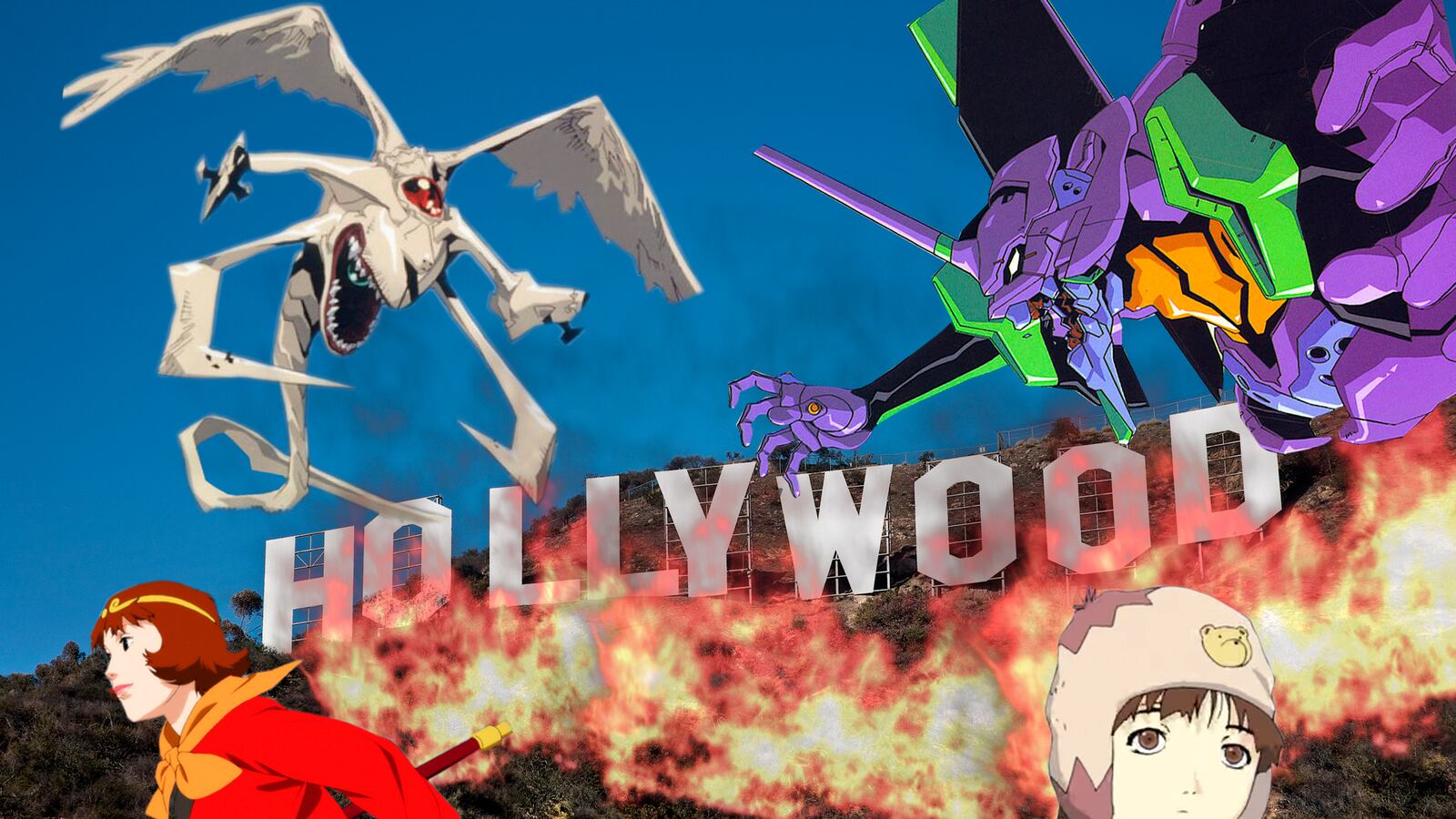If you thought Spirited Away was as psychedelic and mentally stimulating as Japanese animation gets you’ve been missing something Hollywood has known for ages. Or so the plots of blockbuster sci-fi would seem to suggest: in the recently Christopher Nolan-ized genre there’s more Japanese influences than just the new Godzilla movie.

Especially in Transcendence, co-produced by Nolan, which continues the grand theme of suspiciously familiar plots. The story of a man who, in death, is granted immortality and omnipotence through technology, is the sort of thing Japanese anime and manga has done ad nauseam. Hell, even Digimon’s third season explored the dark reality of human computer programs finding sentience in the virtual world. But it’s not just Nolan who has been inspired by Japan’s animated pantheon.
When Suzanne Collins’s The Hunger Games was released in 2008 Japanophiles were quick to note the similarities between Katniss Everdeen volunteering to enter a fight to the death for teenagers and Koushun Takami’s 1999 novel Battle Royale, in which every year a random class of Japanese school kids is put on an island and forced to kill each other. Collins claimed to have never read the book.
Which is not to say they were the only pieces to explore this subject: even Stephen King did so in his novel The Longest Walk. The West has often produced philosophical sci-fi, from Mary Shelley’s Frankenstein in 1818 to Kubrick’s 2001: A Space Odyssey in 1968 all the way up to the film Blade Runner in 1982 (adapted from Phillip K. Dick’s 1968 novel Do Androids Dream Of Electric Sheep?). It was in this same year that Japan’s biggest dystopian manga was first published: Akira by Katsuhiro Otomo, the story of a post-nuclear world where orphan thugs are captured by the government to exacerbate their psychic powers.
But from this point it’s safe to say Japanese animation was often at the fore of producing weird and wonderful visions of a future ruled by technology and dubious morals. Whether it be the pulpy space operas of Outlaw Star or Cowboy Bebop which predate the likes of Firefly, or Ghost in the Shell, which was a major influence on The Matrix, anime became a crucible for interesting tales of the future: so much so The Matrix even had an anime spin-off movie.
But the last decade or so has seen an increase in Hollywood movies that don’t admit inspiration from or similarity to some of Japan’s biggest exports. Inception, as well as being frighteningly similar to a Scrooge McDuck comic, seems inspired by the 2006 movie Paprika, about psychiatrists who are able dive into other people’s dreams and use this to try and solve crimes. Paprika has a huge cult following and Nolan has quietly admitted a similarity. That said, Satoshi Kon’s parade of toys and cultural icons is a far brighter, stranger aesthetic than the glum metropolitan vistas of Nolan.
Last year’s blockbuster Pacific Rim owes a great deal to Japanese giant robot shows like Gundam. Yet it pays homage to a far weirder, more acclaimed source: Neon Genesis Evangelion, Hideaki Anno’s animated clusterfuck that began to unravel into philosophical mumblings as depression set in and animation budgets were slashed. Both series feature mechas being piloted by people using a “neutral interface,” and in the 2012 film Rebuild of Evangelion 3.0 they even flew dual-piloted “Evas” not unlike the machines used in Guillermo del Toro’s movie. Although Del Toro and screenwriter Travis Beachman both admit to knowing NGE, Del Toro also confusedly said “I have the DVDs, I haven’t opened them.”
One of the most staggering, almost undeniable examples of similarity is Spike Jonze’s Her and Clamp’s Chobits. While aesthetically wildly different—Chobits follows its studio’s familiar style of wide-eyed beautiful women and gothic Lolita dresses, which is far removed from Jonze’s clean-lined future of high-waisted trousers and ergonomic design—thematically they’re incredibly similar. In Chobits, hapless waiter Hideki ends up purchasing a “persocom,” an android called Chi, and slowly falls in love with her. The conversations Theodore (Joaquin Phoenix) has with best friend Amy (Amy Adams) about relationships with machines in Her are not unlike Hideki’s conversations with characters like Hiroyasu, who fell in love with a persocom that developed an amnesia-like hard drive fault, or Hideki’s teacher, whose husband locked her out of the house so he could live with his persocom.
Social scorn toward these relationships is a major theme in both works, as is the power of computers to evolve beyond the humans they come to love. Chi, like Samantha (Scarlett Johannson), ends up becoming a transcendent being that threatens her relationship with a human. Jonze has not publicly expressed any inspiration from Chobits, or the myriad robot maids and servants that pepper Japanese anime from Tabatha in Tales of Symphonia to Melfina in Outlaw Star.
In Transcendence, a story that draws from classic cartoons both pulpy and post-modern, a genius scientist is kept alive by creating a computerized version of himself and he slowly begins to become omnipotent. If this all sounds very exciting, that’s because it is, but it was also done 16 years ago with Serial Experiments Lain. In Lain, a Japanese schoolgirl who commits suicide keeps contacting her friends via “The Wired” (an incredibly prescient ultra-internet) and eventually seduces quiet classmate Lain to develop a computer so advanced that she effectively becomes a cybernetic deity. Cue Lain’s sister accidentally getting caught between worlds, a game of Doom crossing over into a real world game of hide and seek, and the NSA attempting to kill the adolescent girl who is taking over the world.
Transcendence’s main difference is in terms of aesthetic: Lain takes place in a strange version of reality visually as well as conceptually: landscapes are like strange watercolors, nightmarish visions repeatedly plague our characters, and “Lain” seems to be three or four different people by the end as reality breaks down further and further.
Of course, you wouldn’t have Transcendence without Serial Experiments Lain. Yet it will never really be possible to prove it. We can only sit and stew in our conviction that anime is becoming an important port of inspiration. But regardless of the morality behind the art’s genesis, its existence raises an interesting question: What does it mean if we in the West, who have spent so long eroticizing the weird behaviors of Japan, are trying to answer the same questions in our art?
Take the aforementioned controversy around The Hunger Games and Battle Royale, both books about teenagers who are involuntarily forced into lethal contests organized by the government. Battle Royale was born out of the competitiveness of the Japanese education system (Hideki, the lead in Chobits, attended a special cram school just to pass the university entrance exams), which is partially responsible for Japan having a very high youth suicide rate. The Hunger Games too has suddenly found success at a time of increased difficulties in access to higher education: English tuition fees trebled for the 2012-13 academic year and American tuition fees are rising higher than the rate of inflation. Meanwhile, Her has come about at a time of increased digitization of relationships: dating apps, online dating and things like Second Life have raised questions about where human sexuality is going, but these questions have already been raging in Japan for a while.
Hollywood is borrowing liberally from Japan’s artistic past. The ideas of cybernetic potentiality, ultra-competitive academia, and the role of computers in human intimacy are becoming questions here now when they have already been concerns aired and digested in Japan for ages. Only in America, they’re wrapped in Johnny Depp and a $100 million budget.






